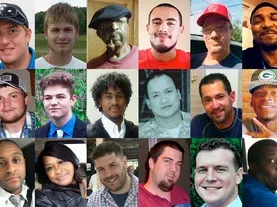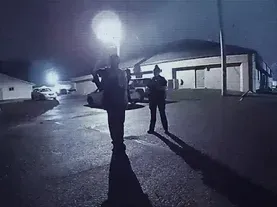>> You got his arm?
>> I got his arm.
>> I'm telling you right now, you're going to get tased if you keep it up.
>> The project is about uncovering hidden deaths.
>> NARRATOR: In Collaboration with “The Associated Press,” an investigation into Police Restraint.
>> People know about the deaths in police interactions, but no one really knows the extent of it.
>> In many cases, it’s sort of unclear what role the police force played in the death.
>> We’re real-world practitioners, so we’re dealing with a real-world problem.
>> Given this reality that officers are often the ones responding to mental health crises.
How are they trained to do that?
>> That’s one of the problems.
There’s an inconsistency there.
>> NARRATOR: And the impact on families.
>> We’re devastated.
We want answers.
>> He should not have died.
>> You find so many families left with unanswered questions.
>> It’s important to identify what went wrong and who was responsible.
>> NARRATOR: Now on FRONTLINE, Documenting Police Use of Force.
♪ ♪ (dog barking) >> It's a nice day.
>> It is.
And it's still chilly this morning... >> Yeah.
>> But I like it.
>> Yeah.
Oh, yeah, it's nice.
>> Feels good.
>> I like this weather.
(chiming) (faint chiming) >> NARRATOR: Associated Press Reporters Mitch Weiss and Kristin Hall have come to Bristol, Tennessee, to talk to Karen Goodwin about the death of her son, Austin Hunter Turner.
>> Hunter knew everyone.
>> Mm-hmm.
>> He was always into something.
Always.
He decided one morning to show the neighbor over here how he was like Superman and jumped off her porch.
>> Wow.
>> Which is two stories, basically.
>> Did he get hurt?
>> No!
He didn't get hurt.
(laughs) >> (chuckles) Look at that.
(laughter) >> He was always trying to make you laugh.
I made sure to raise them in church.
I told them when they were little I'd give them to God, so that no matter what, God had them.
>> NARRATOR: Hunter Turner became a high school athlete and loved motorcycles.
He had a history of minor seizures, and had been using drugs.
But he never had problems with law enforcement until one night in August 2017, when he was 23.
>> It's 11:15, 11:20 at night.
My son's girlfriend, Michelle, she called me and she said, "Oh, God, Karen, something's wrong."
And I said, "What's wrong Michelle?"
"Hunter started going in circles with his arm pointed out.
"And then he fell, and now he's making... moaning noises, and he's not moving."
And I said, "Honey, call 911."
(distorted dialing out) >> (on recording): 911, where is your emergency?
>> (on recording): My boyfriend just started twitching and fell on the floor.
I think he's having a seizure... >> Okay.
And you said your boyfriend is having a seizure.
Is he still seizing?
>> He just started twitching and fell on the floor...
He's foaming at the mouth... >> Don't hold him down.
Just let him, let him work the seizure out.
If he stops shaking, I want you to turn him back to his left side and make sure that if he's got anything like saliva or anything in his mouth, that it runs out, okay?
>> If he's shaking, turn him to his left side?
>> That's the rescue position.
That'll keep his airway open and clear, okay?
Don't put him on his stomach.
>> NARRATOR: Karen Goodwin got to the apartment as the paramedics were arriving.
>> Hunter's down on all fours, and then he sits up on his knees, and he stands up.
And his body is just stiff.
And it's... it's weird to watch because it wasn't that he... and I knew he wasn't in control.
>> NARRATOR: Paramedics were unable to control Turner and suspected he was on drugs.
They called the Bristol police for help.
>> He's in here?
>> Yes.
>> NARRATOR: This body camera footage, which was obtained exclusively by the A.P., shows the situation escalating quickly.
>> Stop.
>> (groaning) >> You got his arm?
>> I got his arm.
>> (groaning) >> I'm telling you right now, you're gonna get Tased if you keep it up... >> I couldn't understand what they were doing or how they were doing it, because you couldn't see very much.
There was anywhere between eight to ten people, it looked like.
And I'm trying to understand, is he calming down, is he coming to?
Is he... What's going on?
>> (grunts) >> Stop it now or you're going to get Tased.
>> Oh!
>> All right, Tase him.
>> Hold on.
>> Whoa, whoa, whoa... >> Watch your arm.
>> You'll get me, too.
You'll get us, too.
>> Ow!
(Taser crackling) >> Hunter, listen.
If I back off, are you going to calm down?
Because you're not going to win this battle.
Do you understand?
>> Put him facedown.
Belly down.
>> Y'all need a spit sock?
>> Yeah.
>> There it is.
Here's the spit sock.
>> Through all this, I was totally helpless.
I couldn't help my kid.
This is my son.
I'm willing to lay my life down for him, but these people are helping him.
So I didn't want to get in the way of the help that maybe he could get.
(officers' indistinct chatter) >> NARRATOR: The officers and medics ended up subduing Turner.
They handcuffed him, strapped him face down on a gurney, and put a mesh fabric known as a "spit sock" over his head meant to prevent biting or spitting.
His mother planned to meet them at the hospital.
>> Are you all done in there?
>> No, ma'am, no.
>> Okay.
>> If you don't mind... >> Is it-- you're all gonna be a while?
>> Yes, ma'am.
>> They just took him off, we're going on to the hospital.
>> Yeah, we'll make sure... >> So the house is secure?
>> Yeah.
>> We'll be here... >> Michelle, let's go baby.
>> NARRATOR: But when she arrived at the hospital, she was told her son had stopped breathing.
>> They were doing compressions, swapping off the two nurses.
And they worked about 15 minutes, and I asked the doctor, "How long can you do this?"
(swallowing) And he said, "We can do it for an hour or so.
Because we've got oxygen going."
Okay.
30 minutes goes by.
And I look, because I'm standing right at his shoulder, holding his hand.
And this whole side of his chest looked like Jell-O when they pushed on it.
It was just giving that free and easy.
And I told them, "That's enough.
(voice breaking): "My baby needs to rest now.
Stop."
>> NARRATOR: The autopsy report said Turner died from multiple drug toxicity-- marijuana and Suboxone, a medication prescribed to treat opioid dependency.
It also cited "dilated cardiomyopathy," a condition that affects the heart's ability to pump enough oxygen-rich blood.
>> We got the autopsy back.
We actually took it to our family doctor.
>> Yeah.
>> I just wanted her to look at it.
And I said, just, you know, "Is there anything in here that's weird?"
And of course, she looks at it.
It doesn't look like there's anything wrong.
It does say an accidental overdose from a "therapeutic to lethal dose of Suboxone," which he was prescribed, and marijuana.
So then she and I are sitting here thinking, "Okay, he's had this... "episode, the seizure.
"Maybe his heart just gave out, and that's why they never could get him back."
>> NARRATOR: Hunter Turner was one of the hundreds of people who die every year after encounters with law enforcement.
Most of those deaths are from shootings.
But others, like Turner's, occur after police use restraint methods that are not supposed to be deadly.
♪ ♪ >> Why don't we go ahead and get going here?
We've got a lot to get through.
>> NARRATOR: For the past three years, a team of reporters from The Associated Press, in collaboration with the Howard Centers for Investigative Journalism and "Frontline" have been compiling and investigating deaths following police encounters that involved tactics known as "less-lethal force."
>> The murder of George Floyd really raised questions for a lot of people about the extent of police use of force.
>> We're looking at deaths that don't involve someone being shot and killed.
Deaths after interactions that involve at least a certain level of force that's beyond handcuff.
Less-lethal force can be a range of things, and it doesn't always have to be excessive use of these things, like a Taser, a baton.
It can be physical force, punching, taking someone down.
It can be when they're down, they're in prone position with a knee on their back.
Forced sedation is an interesting one, the goal is to subdue someone, so that they will stop doing whatever they're doing and perhaps get help in the hospital.
Not all of these people who die are sympathetic characters.
And police show a level of restraint in the sense of, they try and physically subdue them rather than shoot them.
>> NARRATOR: For years, the federal government has struggled to count these fatalities, and the data it has collected is incomplete.
>> The responsibility of the federal government is to track these cases, to understand the full scope of what's happening across the country.
>> Their data collection efforts are hindered by police departments that aren't always sending them the data that they need.
>> You have places, not just individual departments, but in some cases whole states where you just can't get very much information at all.
>> NARRATOR: Despite these limitations, the reporters were able to build an unprecedented database.
(beeping) Through nearly 7,000 public record requests, the reporters collected hundreds of thousands of pages of documents, including autopsy and police incident reports and footage from cellphones and body-worn cameras.
>> We went to medical examiners, coroners' offices, police departments, state agencies that investigate these deaths.
>> Even when they turn over records, sometimes the records aren't all the records.
It may be just the incident report, which is the basics.
Sometimes you'll get investigators' reports and it'll have a little more detail.
Each layer has more and more clues.
"We took him to the ground."
"He was combative."
"He was agitated."
"He didn't listen to us."
"He had superhuman strength."
These were all red flags for us.
Then what we'll do is we try to get the videos to see if the videos actually correspond to what's in the police reports.
>> NARRATOR: Based on the data they were able to gather from 2012 through 2021, they found 1,036 deaths that involved police using some kind of less-lethal force-- a fraction of the overall police contacts with the population, but still, an average of about two per week nationwide.
>> These are still rare, but it happens more often than the public knows about.
>> NARRATOR: In about half of the cases, medical officials cited law enforcement as causing or contributing to the deaths.
In many others, significant police force went unmentioned, and drugs, preexisting health conditions, and other causes were blamed instead.
>> These incidents involving less lethal force are often more complicated than a police shooting would be.
They often involve multiple factors that could lead to death.
In many cases, it's sort of unclear what role the police force played in the death.
>> Not all of these are a George Floyd-level type of case or death.
>> NARRATOR: In about one-third of the cases examined, police were intervening to stop people who were injuring others or posed a threat.
>> Police are stopping them from killing somebody else.
They've broken into someone's home, you know, they're menacing people.
They seem to be having either a mental episode or they seem to be extremely high on a stimulant drug like methamphetamine or cocaine.
You have to consider what sort of a situation police are coming into?
Is this person trying to hurt other people?
Were they going at the police themselves?
That's one of the key takeaways, is that there is a lot of nuance in these.
>> NARRATOR: In the case of Austin Hunter Turner, the body cam videos raised questions for reporter Kristin Hall.
>> (on laptop): You got his arm?
>> (on laptop): I got his arm.
>> The very first thing that I saw was, just how immediate the officers took steps to escalate the situation.
>> Stop it now or you're going to get Tased.
>> This started off as a medical emergency because he was having a seizure.
When the officers arrived, they described using various kinds of force that you would typically see when somebody is being placed under arrest.
So they used a Taser.
>> (on laptop): You'll get us, too.
>> (on laptop): Ow!
(Taser crackling) (Austin groans) >> (on laptop): Stop it now.
>> Then they shackled him with his legs and his arms, and then they put a hobble restraint in between his leg restraints and his arm restraints.
>> (on laptop): Don't put him on his stomach.
Just try to lay him to his left side.
>> When Hunter's girlfriend called 911, the dispatcher told her that he needed to be on his side, not on his stomach.
>> Put him facedown.
Belly down.
>> Push, go.
Push.
>> There we go.
>> Putting somebody face down in restraints in a medical situation is usually not recommended.
The Bristol Fire Department provided to us guidelines that specifically point out that patients should be face up when they are secured, for transportation on a stretcher.
Then they put him into the ambulance I don't know what he's taking but he's fully dilated.
>> NARRATOR: After a few minutes in the ambulance, paramedics realized Turner was not breathing.
>> Is he breathing?
>> NARRATOR: They turned him over and tried to resuscitate him for about ten minutes.
>> What the hell happened here?
>> I don't know.
>> Did we cut his damn airway off?
>> No.
>> Y'all ain't recording, are you?
(clicking) >> NARRATOR: No one from the Bristol police or fire department would comment-- and the forensic pathologist on the case has since died.
The Tennessee Bureau of Investigation looked into the death, but under state law, their records are confidential.
The Sullivan County District Attorney told us that after reading the investigative report and reviewing the body camera footage, he agreed with the conclusion that Turner's death was drug-related and that none of the police officers' techniques had contributed.
But experts who reviewed the case for the A.P.
and "Frontline" disagreed with the autopsy finding that the death was accidental and due to drug toxicity-- including Dr. Roger Mitchell, former chief medical examiner of Washington, D.C. >> The cause and manner of death that was established by the original medical examiner suggested that the drugs that were in his system, as well as his underlying heart disease, was his cause of death.
But I challenge a notion that he died from a drug overdose and a heart disease when he's strapped face down, with a spit hood on his face and being pushed into the soft padding of a, of a stretcher.
>> How would you have ruled it?
>> Based on what I saw, I would I would rule his case a homicide.
I would suggest that his death was contributed to by another.
And when you have any individual that is in altercation with another and you believe that, that is contributory, then that case should be designated as a homicide.
>> When an autopsy is done, a pathologist will decide on what's called the manner of death, which is homicide, accident, natural, suicide, or undetermined.
>> Homicide doesn't mean that the officers did anything wrong by itself, it just means that the medical examiner is concluding that, but for the actions of the officers, that's what caused this death.
The manner of death does not imply guilt.
>> You see, the way that those determinations are so important to whether a case really has much accountability or not.
>> When you don't label it a homicide, you are then less likely to receive justice in a system that typically will investigate it if it's a homicide.
>> One of the findings of our project is that a majority of our cases, the medical examiner ruled they were accidental, undetermined, or natural.
>> NARRATOR: Of the 957 cases for which the A.P.
had documents indicating the manner of death, 28% were classified as homicide.
>> There are some medical examiners that believe when law enforcement is engaged in an altercation, that intent must be established in order to call it a homicide.
I don't hold that school of thought.
If those actions led to the death, then I will call those cases homicides and then allow for the legal system to determine whether or not there was an intent or not, um, that legally needs to hold them liable.
>> NARRATOR: One of the main findings from the database is that the death toll fell disproportionately on Black people.
Non-Hispanic Black people made up a third of the 1,036 deaths examined, despite representing only 12% of the U.S. population.
One case that drew protests and concerns was the death of Jameek Lowery in Paterson, New Jersey-- a city with a history of tension between law enforcement and its Black residents.
>> He was really outgoing and a goofball.
Every morning he had a routine-- he called my mom.
Straight from calling her, he calls me.
>> What were some of, maybe, the challenges in his life?
>> He was bipolar.
So he, um, he went off his meds.
As far as how he lived with it, he had some good days and he had some rocky days.
>> NARRATOR: On January 5, 2019, Lowery called 911.
He told the operator he had taken ecstasy and was paranoid.
Paramedics took him to the hospital, where he was examined, but removed by security for causing a commotion.
He then went to the Paterson police headquarters, where he started filming himself, broadcasting the video live to Facebook.
>> Yo, they're trying to kill me.
>> Ain't nobody there.
>> They're trying to kill me.
Can I get some water?
Please?
>> NARRATOR: The officers remained at a distance.
>> Please don't kill me, officers.
Please don't kill me-- Ma, I love you, Ma.
>> NARRATOR: After several minutes, the live stream ended.
It is not entirely clear what happened next.
The police called for an ambulance to take Lowery to the hospital.
But by the time he arrived, he was unconscious.
>> We rushed up to the hospital.
He was there and he was on life support, and, um, they're not sure what's going on.
They told us they had no idea.
They found him unresponsive.
He was bruised really, like, really, really, really bad.
I knew he was gone.
>> NARRATOR: Lowery died two days later... >> This is our city!
>> NARRATOR: ...igniting protests and accusations of police brutality.
>> I want justice-- I need the truth.
>> We're broken-- we're devastated, we want answers.
>> NARRATOR: The police and county prosecutor maintain that Lowery became combative and had to be restrained on the way to the hospital, but that the officers' use of force was not a factor in his death.
Lowery's death was ruled an accident by the medical examiner, who said he died of cardiac arrest while under the influence of a psychoactive drug known as "bath salts."
But Lowery's family filed a federal lawsuit against the hospital, the city, and three Paterson police officers.
And they hired Dr. Michael Baden to perform a second autopsy.
Baden also reviewed police and medical records, including some which were not available publicly.
>> After he was put in the ambulance, they had a struggle.
And in the course of the struggle, they were trying to restrain him.
And at the hospital, they diagnosed that he had severe brain damage due to lack of oxygen, which occurs when there is interference with breathing.
The bruises were consistent with a struggle and being punched while he was in the back of the ambulance.
>> (softly): Right.
>> And that whole process took just a few minutes.
>> NARRATOR: Baden said that Lowery suffered "traumatic blunt force" injuries and that the levels of drugs in his system were not enough to stop his heart.
He rejected that the death was accidental, and attributed it to cardiac arrest and kidney failure from the police restraints.
>> The final diagnosis was wrong.
He died from the way he was restrained in the ambulance.
>> I want people to know what happened to him.
I don't want them to just look at my brother and think that, "Oh, he was just a junkie who had a mental breakdown."
Like, 'cause that's the picture that they painted to the world of who my brother was, and he wasn't that.
>> NARRATOR: Neither the police nor the prosecutor's office would comment.
But in court papers, attorneys for the city said officers acted with "reasonable and proportionate force" while placing Lowery in custody.
In 2023, the Paterson police were put under state control amid ongoing complaints about use of force and a lack of trust within the community.
(sirens blaring) As with Jameek Lowery and Hunter Turner, over and over in the database, reporters found cases of police having to respond to people in medical and mental health crises, situations law enforcement is often not trained to handle.
>> Police themselves are in many ways front line, you know, social workers and drug counselors, and, you know, they have these, these many different roles because of the fraying of, of the social safety net.
>> I think the infrastructure, if you will, outside of law enforcement, there's been a dramatic failure, and it seems to me that it's gotten worse and worse over the years.
>> NARRATOR: Jack Ryan is a lawyer and retired police captain, and one of the many law enforcement experts the A.P.
and "Frontline" spoke to.
>> So given this reality that officers are often the ones responding to mental health crises, how are they trained to do that?
>> That's one of the problems-- there's an inconsistency there.
So for example, when I do training, I train, "Hey, look, this may not be something that you should be dealing with at all."
That's number one-- number two, let's get E.M.S.
on the scene.
Do we have mental health resources that will come out to the scene?
Do we have plenty of backup in case the thing does turn violent?
So there are steps that we can take, and a big part of the training is recognizing that certain things are dangerous.
Prone restraint, for example.
>> NARRATOR: Prone restraint, the common police tactic of restraining someone facedown.
It is one the most prevalent kinds of less-lethal force found in the database: 740 instances.
>> There's times, tactically, where officers have to get people immobilized in order to accomplish handcuffing.
That is a trained tactic to do that.
But you don't want to do that for any kind of prolonged period.
You want to do it, get them handcuffed as quickly as possible, and get them off their stomach.
When done properly, in most cases, it's not a dangerous situation.
>> NARRATOR: But prone restraint can sometimes lead to cardiac arrest or "positional asphyxia"-- when a person's position interferes with breathing, especially if pressure is applied on the back.
People impaired by medical conditions or drugs are especially at risk.
>> I can't breathe!
>> There are cases in which we have someone saying, "I can't breathe."
And that can be said in a very haunting way.
They're crying out for their mom as they're dying.
>> (shrieking): I can't breathe!
Mama!
>> NARRATOR: The reporters found 27 cases where police continued to use prone restraint after handcuffing people, and despite complaints of impaired breathing.
>> When a subject tells an officer that I can't breathe, and they're on the ground, in prone restraint, what should-- how should officers respond to that?
>> The officers should treat that as they can't breathe.
Um, you know, one of the things, one of the biggest myths out there is that if a person's talking, they're breathing.
A lot of times, we see things like officers saying they were still actively resisting.
What officers perceive as act of resistance, that thrashing about, may be unconsciously fighting for air.
The bottom line is, as law enforcement, we can immediately get them off their stomach as soon as they're handcuffed, put them on their side, which should enhance breathing-- we call that a rescue position.
>> NARRATOR: In about half of the incidents where prone restraint was used, the reporters found that officers didn't promptly turn over the person once they were handcuffed or under control, despite decades of warnings within law enforcement about the dangers.
Although there is no national law or rulebook on using prone, in 1995, the Department of Justice warned that pinning someone facedown could restrict breathing.
It later advised police departments to develop policies to prevent positional asphyxia.
>> There were warnings that have gone out years ago, and there are some training centers that have been teaching it for a long time, that when you put somebody in prone, you have to be careful to avoid positional asphyxia.
>> NARRATOR: The A.P.
looked at how officers are trained in prone restraint around the country.
>> I wanted to understand what sort of training officers had.
Did they understand that if you hold someone in that position, they might have trouble breathing?
Training for police officers in the United States is inconsistent.
It's different in every state.
It's different in every community.
I've looked at the agencies across the country.
There's, they're called POST, it's Peace Officer Standards and Training.
And they all oversee what officers get training in.
>> NARRATOR: The A.P.
reached out to agencies in every state.
27 responded.
Ten of them said they don't require positional asphyxia training.
17 did.
But even with training, the A.P.
found cases in which officers repeated errors that experts have been trying to eliminate.
As was the case in Sylvester, Georgia, of Terrell Allen Clark, a 47-year-old long-haul truck driver with a history of heavy cocaine use.
In October 2016, a woman called 911 and said that a paranoid man was banging on her door.
Sergeant Adam Celinski was the first officer on the scene.
>> Pulled up and the guy came from around the house.
Called him over to, to the car, start talking to him.
Come on right over here-- come right over here.
>> Yeah, tell him to call the police.
>> Come right over here.
What's going on?
>> I need some help, sir.
>> You got anything on you?
>> No, sir.
>> Put your hands right here, put your hands right here.
What's going on?
>> High.
>> Huh?
>> High.
Tripping.
>> NARRATOR: Celinski, who is now a lieutenant with the county sheriff's office, was one of the few police officers willing to discuss the events leading up to the death of someone he tried to restrain.
>> I went to try to put him in cuffs, and he went to fighting.
Hands on the car!
Don't... Don't-- don't move, do you hear me?
>> Yes, sir, I'm scared, man.
>> I understand, but you need to stay calm, okay?
>> Yes, sir.
>> All right?
We're going to put cuffs on you.
>> Okay.
I didn't do nothing to nobody, sir.
>> I know, but you got to stop, you got to calm down.
(handcuffs click) All right?
>> Help me!
>> Stop!
>> Help, help, please!
>> Stop, stop!
Calm down, man!
We fought, he'd calm down, we'd talk.
We'd get in cuffs.
He tried, he'd explain a little bit more what was going on.
He'd start fighting again.
Calm down, calm down.
>> What did you take?
>> Powder, sir, powder.
>> What did you take?
>> Powder.
>> Powder?
>> Yes, sir.
>> NARRATOR: From her house across the street, Alphallia Farrie saw what was happening, and recognized Al Clark.
>> I just saw two officers and a young man on the ground.
They had him down and handcuffed.
They weren't being rough with him, but he was squirming a little bit, you know?
And I asked him to stop moving around so they wouldn't hurt him.
We ain't going to let them kill you.
>> Calm down.
We're not trying to hurt him.
>> They ain't trying to hurt you, Al.
Just be still, Al.
>> Stay still, man.
>> NARRATOR: By now, Clark appeared to be physically in distress.
>> I can't breathe.
>> Yes, you can, calm down, calm down.
>> Be still, Al.
And he calmed down, and, uh, and I told the officers to make sure he was breathing.
>> His heart's still beating.
>> He's still okay.
He's still breathing, ain't he?
>> Yeah, it's just really shallow.
>> Okay.
>> 9-1, be advised, subject's unconscious, got shallow breathing.
>> So what went through your mind when he stopped moving and...
Were you aware right away that, that he had stopped breathing?
>> It took, it took a second, because I didn't, I didn't know if he was just, he was finally just relaxing, because, because he was starting to, you know, not be as combative and, and talking as much.
He was starting to slow down.
>> He ain't responding now.
>> 9-1, they need to come 10-18.
He is not responding, not responding.
(in interview): I don't remember exactly how long it was.
We checked his pulse, checked his breathing, and he wasn't, so we immediately took the handcuffs off and started doing CPR on him.
>> Flip him over, I'll do a sternum rub on him.
He'll wake up.
>> Take these cuffs off.
>> He's not responding at all.
(siren blaring in distance) >> 9-1, patient may not be breathing at this time.
>> NARRATOR: Clark was pronounced dead at the hospital.
The medical examiner ruled the death an accident, caused by cocaine and heart disease, not due to police force-- a finding the experts consulted by the A.P.
and "Frontline" agreed with.
>> NARRATOR: But Jack Ryan said that even though the use of restraint may not have caused Clark's death, Officer Celinski didn't turn him over quickly enough after handcuffing him.
>> Officers make mistakes of professional judgment.
They don't always rise to the level of criminality.
This officer in this particular case is really trying to do the right stuff.
You can hear it.
You don't hear an officer screaming, swearing, yelling.
You hear an officer trying to calm the person down, trying to de-escalate the person.
Unfortunately, the method of restraint wasn't consistent with best practices.
That officer does not seem to be well-trained or have familiarity with prone restraint.
>> NARRATOR: Although the risk of positional asphyxia was officially part of Celinski's basic training curriculum, he said whatever he may have been taught didn't stick with him.
And, he said, even if he had more training, it wouldn't have changed the outcome.
>> I don't think that training for that particular incident would have made a difference.
I don't think, in this case, him laying on the ground was part of his reason for dying.
I felt like I was fair and I did everything I could.
Minimally physically intrusive.
Just wished he would have calmed down long enough for us to get help to him.
>> NARRATOR: Nevertheless, Celinski said that he has since undergone more training and changed the way he uses prone.
>> Now, if we have to put somebody on the ground with their chest down, with the handcuffs behind the back, we're gonna do it on their side, not completely on their chest on the ground, because we've learned that, hey, that's going to-- that can make them difficult to breathe.
>> For a subject against the wall in a fighting stance... >> NARRATOR: Despite the widespread agreement on the dangers of prone, the reporters found several state-certified police training centers continuing to teach that it doesn't lead to positional asphyxia.
>> ...goes to a prone control.
>> NARRATOR: David Rose is among the most senior police instructors in California.
>> We're in the real world-- we're real-world practitioners.
So we're dealing with a real-world problem.
>> NARRATOR: He has trained generations of officers that prone restraint is safe.
>> The mere fact that you put somebody in a prone position is, is not going to kill them, absent some other factors.
And as the studies have shown, putting weight on a person's back in a prone position does not lead to them expiring.
Okay?
Unless it's enough that it can actually literally squash them.
And, if that was true, every football game, we'd have bodies laying on the football field.
>> Is there ever an instance where they're having trouble breathing?
>> There is a thing called agonal breathing.
And we were told years ago, if they're talking, they're breathing.
We now teach cops, you can sort of tell, you can tell, agonal breathing is pretty, pretty unique.
It wouldn't be somebody saying... (in clear voice): "I can't breathe."
Would be... (struggling): "I... can't...
breathe!"
You know?
(in normal voice): And then you go, "Okay, "let's get this guy into custody quick, and... "To get him rolled on his side, okay?
And, and get the medics in here to treat him."
>> NARRATOR: Like many experts we consulted, Roger Mitchell disputed Rose's claims on the safety of prone and took particular issue with his football analogy.
>> Individuals that are football players, these are athletes.
They also have protective equipment on.
So this notion that those are the similar circumstances to an individual that is being placed on their stomach and wrestled down and placed in these positions with law enforcement, to suggest that those are similar circumstances is, is a faulty analogy.
>> NARRATOR: Determining the impact of any one form of less-lethal force is difficult because multiple techniques are often used in tandem.
>> Officers will generally get a person on the ground in prone, so that they can handcuff them.
But if there's resistance, then they end up using other types of force.
>> NARRATOR: In the escalating chain of events, the reporters found another controversial form of restraint being used.
>> We saw this pattern where people who had been subjected to the use of force and restraint by police officers, were then given a shot of a powerful sedative like ketamine or Versed by E.M.S.
professionals.
Shortly thereafter, they suffered cardiac and respiratory arrest, and they died.
>> NARRATOR: The sedatives are administered by paramedics, sometimes encouraged by the police, and supporters say it helps quickly deal with behavioral emergencies and is safely given thousands of times a year.
>> NARRATOR: But as its use has grown, it has come under increasing scrutiny, including by some in the E.M.S.
community like Eric Jaeger, who has used it in the field himself and now trains other paramedics.
>> I think ketamine, used properly, is a very safe and effective drug.
I think that the way we rolled it out to the E.M.S.
community, without, uh, proper understanding of the risks involved and how to mitigate those risks, created the risk of harm.
>> NARRATOR: Among those risks are how the sedatives can interact with drugs or alcohol already in someone's system, and how they can further restrict breathing of someone already being restrained and in distress.
>> There was a fair number of times where individuals were chemically sedated, where, with the understanding we now have, we would elect not to perform that chemical sedation.
>> NARRATOR: Nearly one of every ten people in the database had been sedated before they died, although it was impossible for the A.P.
to determine the role the medications played in the deaths.
The injections were rarely cited in official reports or investigated.
>> Only in a small number of cases was the sedation listed as a, as a cause or even a contributing factor to the deaths.
And they weren't necessarily looked at as a factor that could have resulted in the outcome of the case.
>> NARRATOR: One such case was Taylor Ware, a 24-year-old veteran who grew up near Kansas City, Missouri.
>> This is Taylor up top here... >> Look at that face he's making in that Trouble picture.
>> Ah, yeah.
He's... Yeah.
>> (chuckling) >> This, this one's a good one.
Um... Taylor, he had a very infectious smile.
um, kind of smiling, just, it, it would touch your heart.
It would warm your heart.
>> When did he tell you that he was thinking about going into the Marines?
>> Six months after he graduated.
I think he wanted to follow in my footsteps and my father's footsteps.
>> NARRATOR: While in the Marines, Taylor Ware was diagnosed with bipolar disorder.
He was honorably discharged and moved to Kentucky with plans to attend college.
>> NARRATOR: In 2019, he was arrested after exhibiting manic behavior in public, and his mother and a friend came to drive him home for mental health treatment.
>> NARRATOR: At a rest stop in Dale, Indiana, his mother called 911 for help.
>> (on phone): 911.
What's the location of your emergency?
>> (on phone): Um, we are at a rest stop.
I believe it's in Dale, Indiana.
My son is bipolar, and I was trying to get him home to Kansas City, and he is having an episode.
And he, you know, will not get back in the car.
He's getting very agitated, and I, I need, uh, mental help, I need someone to come.
>> Okay.
>> Uh, so that he can get help at a mental hospital.
>> We will get an officer out that-a way.
>> And will you please make sure to tell them he needs mental help?
>> Okay.
(chatting quietly) >> Yeah, I'm all right.
>> NARRATOR: Pauline Engel, his mother's friend, captured parts of the incident on her cellphone.
>> At what point did you start to record?
>> I think I'm going to record him so he can see how he's acting, so he'll know why we're concerned and, you know, know what he does when he gets like this.
And that's when I started recording for Taylor to, so we could show him, cause I think he blacked out.
Like, it's like he didn't really realize what he was doing.
>> (voice quavering): When the first officer arrived, I said, "You need to wait for backup."
And he got his dog out of the car.
And I said, "No, you need more officers.
"My son's not in his right mind.
"He has no idea where he's at.
(Pauline sniffling) He doesn't know what he's doing."
>> NARRATOR: The cellphone video shows how the incident unfolded.
>> The first officer to arrive was an unpaid reserve marshal from the nearby town of Dale.
Taylor Ware goes to shake his hand, and they sit down in the grass.
>> The first thing that happened is the dog tried to attack Taylor.
(dog barking) >> And that set him off.
>> Why is the dog going crazy?
Is he doing something?
(dog barking) >> He eventually gets up, and he starts walking away... (Robin and Pauline chatting) >> And the officer and his dog follow Taylor.
This is the bad part.
>> The officer says that Taylor Ware pushed him and started running away.
And that's why he released his dog.
>> Oh, God, stop.
>> NARRATOR: Engel's footage doesn't show the confrontation... >> Stop, stop!
>> NARRATOR: ...but a few frames capture the officer's dog taking Ware down.
>> Oh, my God.
>> Stop, Taylor!
>> (on phone): Mmm.
Oh no.
>> Taylor, don't!
Don't.
Stop, please.
>> Let go of my dog!
>> Let go, please!
>> Let go of my dog!
>> Get on the (bleeping) ground!
>> Oh, my God.
>> Turn around!
He's fighting.
Turn around!
>> Let go of my (bleeping) dog!
>> Oh, my God.
>> Taylor, stop, please.
>> (on phone): Quit fighting my dog!
>> He's not fighting him.
>> (on phone): Let go!
>> (voiceover): He's not fighting his dog.
>> NARRATOR: A second officer on the scene, who said that Ware had spat at him and tried to grab his Taser, shocked him three times.
>> What if they Tase him... (Taser buzzes) Oh, God.
(gasps) >> (Taser buzzing) >> Ellie.
Ellie, good.
Good, Ellie.
>> Stop.
>> (on phone): Don't touch my dog.
We need backup.
Call 911, we need backup.
>> ENGEL: 91... >> We need backup.
>> All right.
>> NARRATOR: Another officer arrived and helped handcuff Ware.
A paramedic gave him a shot of ketamine.
>> Ketamine!
Where's the ketamine?
>> What's that?
>> Bring the ketamine.
He's fighting.
>> I don't know.
I'm guessing it's a sedative.
(heavy breathing) >> Oh, they're gonna give him a shot.
Okay.
(heavy breathing) >> NARRATOR: This is police body camera footage after they gave him the sedative.
He was then put on a stretcher.
>> Is he breathing?
>> (voiceover): Shortly thereafter, they noticed that, you know, he was not breathing and they rushed him to a hospital.
>> NARRATOR: Pauline Engel continued to film when the first responding officer approached her and Taylor's mother.
>> I wish maybe we should have just waited and let him sit there.
>> No.
>> Because I think more people... >> Well, the thing is, he's walking towards traffic... >> Yeah.
>> ...and then he started messing with that car.
And he came up to me and went like that to my chest.
>> Yeah.
>> Yeah, I saw.
>> And that's an assault.
And so I gave him a lawful order to stop, he ran.
Classic textbook dog deployment.
>> Yeah.
>> NARRATOR: Ware had fallen into a coma.
He died three days later at the hospital.
>> The Indiana State Police said they investigated the case, so we filed a request for their full investigation file.
And they told us that all of those records were confidential.
A letter from the local prosecutor in Indiana said he was not gonna file any criminal charges against the officers involved.
>> NARRATOR: The A.P.
reached out to the police departments the officers, and EMS, and they declined to be interviewed.
>> NARRATOR: Three police practices experts reviewed the case for the A.P.
and "Frontline."
They said the first officer should have waited for backup, and that using the dog was unnecessary and excessive.
>> Canines are looked at as a significant use of force.
It's generally one level below deadly force.
So, it's, it's limited to serious offenses.
Bringing the dog out, in my mind, in a mental health case was not the right action because it's only gonna make it more agitated, more aggravated.
It's gonna escalate the event.
Based on even the report of this minor touching, insignificant for purposes of the degree of force you're gonna apply to the apprehension.
>> Wasn't proportional.
>> Not proportional.
>> The prosecutor who reviewed this case declined to charge the officers.
And then in his letter announcing that, he said they did absolutely nothing wrong, they handled this incident with great restraint and great professionalism.
I'm curious your thoughts on that.
>> You know, I would, I would disagree that it was properly handled.
Um, I would agree that it's probably not a prosecution case.
Um, the officer shook his hand.
The officer tried to establish a rapport, you see that.
Did the officer make some mistakes?
In my mind, yes.
Uh, but were they, uh, rise to the level of criminality?
No.
What I see is definitely a lack of training, um, on the when it's appropriate to do certain things.
>> NARRATOR: The medical examiner didn't respond to requests for comment.
His ruling said that Ware died from "excited delirium," a term used to describe a state of potentially life-threatening agitation, but now widely discredited by the medical establishment.
>> We've now come to understand that excited delirium is a deeply flawed concept.
In many cases, the definition of excited delirium was built on racial stereotypes, and probably more fundamentally, excited delirium was a concept that, in many of these cases, served to shift the focus from the actions of the first responders-- restraint or chemical sedation by the police or by E.M.S.-- to the individual for using methamphetamine, for engaging in criminal activity, for, uh, in some cases, suffering from mental health emergencies.
>> NARRATOR: Taylor Ware is one of 142 cases in the A.P.
's database that list "excited delirium" as a factor in the cause of death.
>> When did you start to see that it was flawed?
>> Our recognition that excited delirium was flawed, uh, really only came, as we began to take a hard look at, um, cases like Elijah McClain and some of the other tragic deaths that we've seen where excited delirium was used.
>> NARRATOR: The night before Ware's encounter at the rest stop, an unarmed man named Elijah McClain was restrained by police in Aurora, Colorado.
The officers called for paramedics, who injected McClain with ketamine.
He went into cardiac arrest and died a few days later.
>> Elijah McClain's case was a stepping-off point where we began to take a harder look at other deaths.
And what we discovered was troubling.
We discovered there were many other cases where the combination of prone restraint and chemical sedation had resulted in death.
>> NARRATOR: Colorado placed significant restrictions on the use of ketamine in the field, including banning police officers from directing paramedics to administer the sedative.
>> NARRATOR: One officer involved in McClain's death was convicted of criminally negligent homicide and third-degree assault.
Two others were acquitted.
In a rare homicide prosecution of medical personnel, the two paramedics who'd injected McClain with ketamine were also found guilty.
Dr. Roger Mitchell was an expert witness in the trials.
>> Every excited delirium case in this country should be looked at and establish what, what the true cause of death is.
>> NARRATOR: Mitchell has been advocating for a new system to record deaths in police custody.
>> There needs to be a checkbox on the U.S. standard death certificate that ensures that these cases can be reviewed as not just singular events, but as systems of events that, that occur.
There's a smoking checkbox on the U.S. standard death certificate.
So any disease that's associated with smoking, we can see that on the death certificate.
And so, if we want to stop and prevent individuals from dying in the hands of law enforcement or associated with the criminal legal system, then we need to create a category of data collection surrounding those so that we can generate the proper policies and proper ways of preventing these deaths.
>> We all love you and miss you so much.
(kisses hand, sighs) >> The project is about uncovering hidden deaths.
These are the deaths that are the hardest to find.
This cuts across every state, cuts across every socioeconomic boundary.
>> We love you, bro.
>> Those are the things that I think about as I'm reporting this story.
>> Now he could ride like no man's business.
Riding was the one thing we all had in common.
(motorcycle engine accelerates) >> Once you put your helmet on, you're in your own little world.
So there's also some escapism involved in it.
It's you, it's the bike, it's the road, that's it.
>> NARRATOR: Six years after the death of Hunter Turner, Karen and Brian Goodwin visited a roadside memorial made by his friends.
>> It's amazing that kids his age thought enough they wanted him up here.
And they tended to it quite a bit.
>> These hidden deaths.
These people all had loved ones.
And when they die like this, there's no closure for the families.
>> He's always with us.
I mean, you can feel his presence, you know?
He was our baby.
♪ ♪ >> Go to pbs.org/frontline for a Q&A with members of the team that made this film.
>> The responsibility of the federal government is to track these cases.
>> You have to consider what sort of a situation police are coming into.
>> These were all red flags for us.
>> And for more coverage from our partners at “The Associated Press,” connect with FRONTLINE on Facebook, Instagram and X, formerly Twitter, and stream anytime on the PBS app, Youtube, or pbs.org/frontline.
Captioned by Media Access Group at WGBH access.wgbh.org >> For more on this and other "FRONTLINE" programs, visit our website at pbs.org/frontline.
♪ ♪ FRONTLINE's "Documenting Police Use of Force" is available on Amazon Prime Video.
♪ ♪











